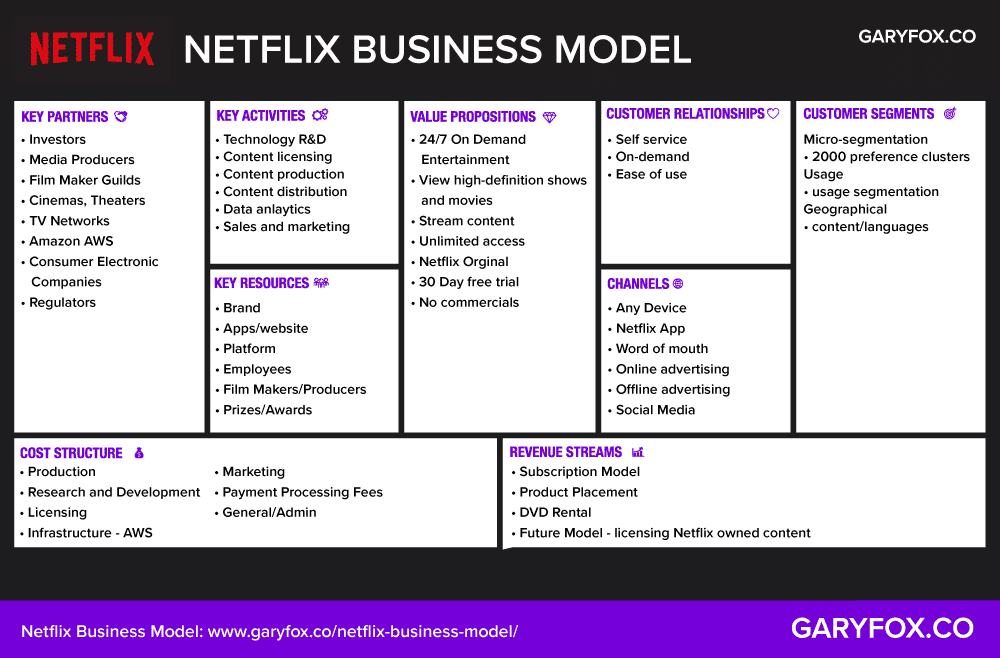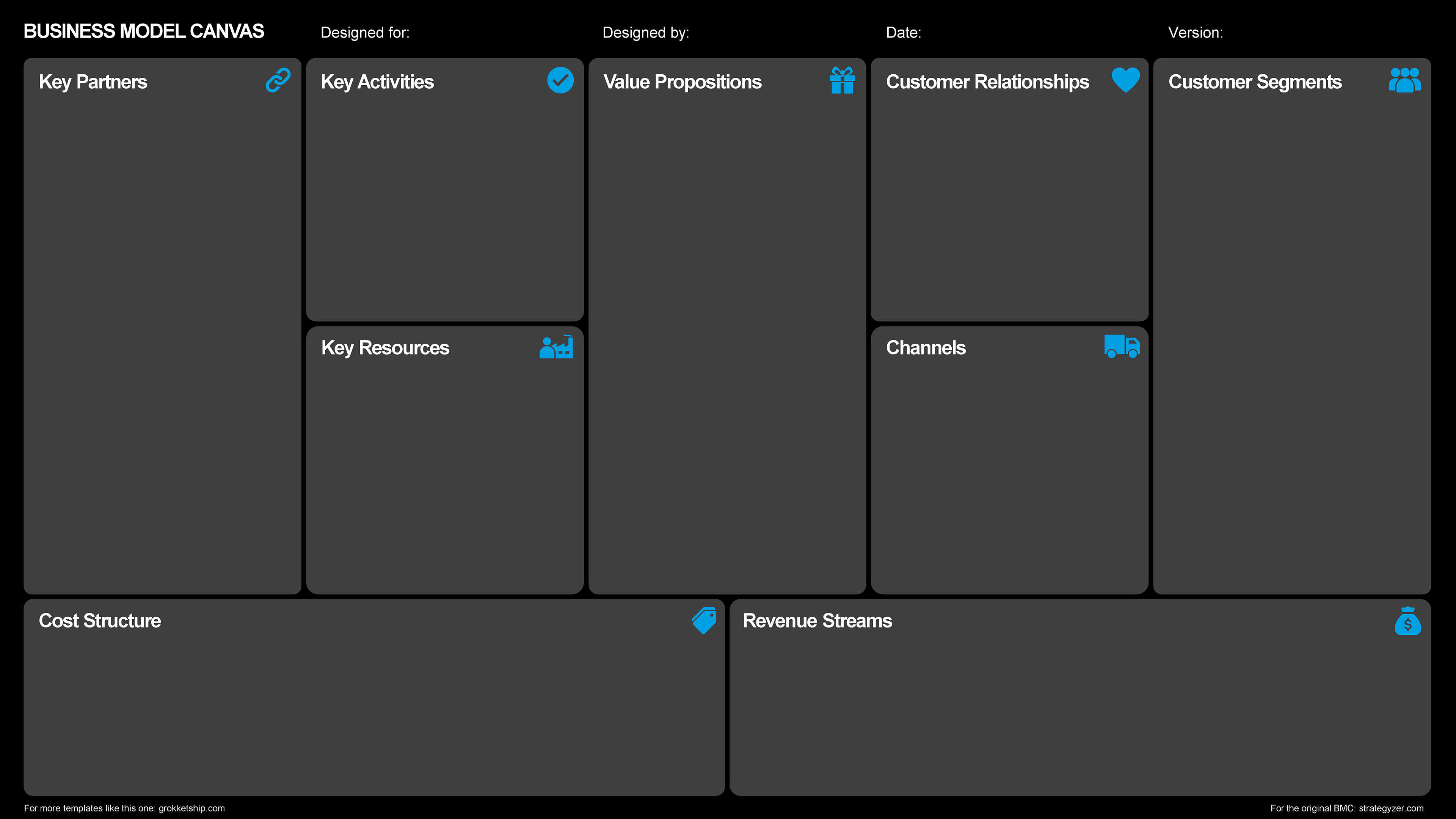
Business Model Generation Summary
Canvas – The nine building blocks
1. Customer segments
For whom are we creating value? Who are our most important customers?
Mass market. Niche market. Segmented. Diversified. Multi-sided markets.
2. Value propositions
Value can be quantitative or qualitative. Which one of our customers problems are we solving? Needs we satisfy? Bundles of products and services for each customer segment? What value do we deliver?
Newness. Performance. Customization.
Example Value propositions:
Getting the job done. Design. Brand and status. Price. Cost reduction. Risk reduction. Accessibility. Convenience and usability.
3. Channels
Through which channels do our customer segments want to be reached? How are our channels integrated? Which ones work best? Which ones are most cost efficient? How are we integrating them with customer routines?
We can distinguish between direct channels indirect channels as well as owned channels and partner channels.
Channels have five distinct phases.
- Awareness.
- Evaluation.
- Purchase.
- Delivery.
- After sales.
4. Customer relationships
What type of relationship does each customer segment expect us to establish and maintain? What have we established so far and not established? How costly are they? How are they integrated with the rest of the business model?
Personal assistance. Dedicated personal assistance. Self assistance. Automated services. Communities. Co-creation.
5. Revenue streams
The two basic revenue stream types or transaction revenues from a one-time payment and reoccurring revenues. Prices are either a fixed menu or dynamic based on market conditions.
What value are customers really willing to pay for? What are they paying now? How are they paying? What would they prefer to pay? How does each revenue stream contribute to the total company revenue?
Asset sale. Usage fee. Subscription fees. Renting or leasing. Licensing. Brokerage fees. Advertising.
6. Key resources
What key resources do we need for our value propositions, distribution channels, customer relationships and revenue streams?
Physical. Intellectual. Human. Financial. For further examples of key resources, read this article.
7. Key activities
What key activities to our value propositions distribution channels customer relationships and revenue streams require?
Production. Problem-solving. Platform and network. For further examples of key activities, read this article.
8. Key partnerships
There are three motivations for creating partnerships:
- Optimization and economy of scale.
- Reduction of risk and uncertainty
- Acquisition of particular resources and activities
9. Cost structure
Is your business cost driven or value driven? Cost structures can have the following characteristics:
Fixed cost. Variable cost. Economies of scale. Economies of scope.

Download an original high-res PDF of this image directly from the Strategyzer website. OR you can download an easier to edit PowerPoint version of Business Model Canvas here.
Canvas Examples
AirBNB as modeled by studiousguy.com

Uber as modeled by Denis Oakley.
Tesla as modeled by Gary Fox.

Snapchat as modeled by Daniel Pereira.

Netflix as modeled by Gary Fox.
Patterns
Unbundling Business Models
This theory holds there are three fundamentally different types of businesses. Customer relationship businesses, product innovation businesses and infrastructure businesses. Ideally a company should focus on one of these and create partners to handle the other two to avoid conflicts and undesirable trade-offs.
The Long Tail
This is a shift from selling a small number of hit items in large volumes to selling a very large number of niche items each in small quantities. The author feels eBay is an example of this. Each item may not sell a lot but the total net volume is enough to create large revenue.
The lower cost of producing professional level music in short films has allowed an army of creators to create niche content. For each creator it doesn’t need to be a worldwide best seller. When YouTube hosts such a large range of indie creator work, people know they can find videos on just about anything they need they going to YouTube. There’s been a similar effect in the book publishing industry we are just about anyone can get their stuff published in a small number of limited runs. This is created an incredibly massive selection of niche topics and information like never before seen.
The difficulty of this type of business is finding interested niche buyers. Creating powerful SEO recommendation engines, user ratings and communities are what has made this possible.
Multi-Sided Platforms
This brings together two or more distinct interdependent groups of customers. there is only value to one group if the other group is also present. Google and eBay of course or examples of this. The platforms value is driven by the size of its client base, a phenomenon known as the network effect.
All of Google’s money is driven by Edwards revenue which only has value because nearly everyone uses Google to search. Web servers and content owners of course use Google for free. Google essentially has three services:
- Web search.
- Ad words or advertising.
- Third-party content monetization known as AdSense.
Proprietary matchmaking algorithms and extensive IT infrastructure make all this possible. Knowing exactly how many users you will bring to the table on one side must be a critically accurate calculation. Your pricing to advertisers must cover your costs if you were going to give away all your other services for free. But if you don’t bring enough users to the table you will go in the hole.
Free as a Business Model
To me this is simply a multi sided platform pattern where at least one of the customer segments is able to benefit free of charge.
Freemium:
Get the basics for free to pay for more. Skype to this by offering free calls but the ability to call land lines and smart phones for a fee. 10% of its users were paying, generating $550 million annually.
Open source: freemium with a twist
This is a business model used by red hat where it takes the legal liability of a stable tested service ready version of open source software. They charge a subscription fee for this and promise to support this version for period of seven years.
Insurance is essentially freemium upside down. A bunch of people put money into a pool and should disaster ever strike the minority is covered and receive benefits for free.
In order for premium to work the free platform must have extremely low cost.
The other alternative is called bait and hook. This is what mobile carriers do with free phones and inkjet printers do with ink, Gillette does with razors and razor blades.
Open Business Models
Incorporate intellectual property external research and development as we don’t have to research all R&D to win. Utilize people inside and outside of our company.
Strategy
On page 201 an outline of foresight:
The Environment Map
Key trends, it is free forces, market forces, and macro-economic forces all put external pressure on your business model canvas. The book goes on to write a detailed breakdown of each one of these forces are.
SWOT analysis
Page 216 through 223 provide detail question list in order to create a strengths, weaknesses, opportunities, and threats analysis.
Pg 226. They combine the Blue Ocean strategy with Business Model Canvas.
4 actions:
- Eliminate.
- Reduce (make worse).
- Raise (improve).
- Create (new).
Process
The business model design process has five phases:
- Mobilize.
- Understand.
- Design.
- Implement.
- Manage.

YOUR BUSINESS AS MODELED BY YOU! Download you very own easy to edit PowerPoint version of Business Model Canvas here.
Further Info
- You can access original info, tons of free guides, question lists, planning tools and more for Value Proposition Design directly from the Strategyzer website.
- You can download an easier to edit PowerPoint version of Business Model Canvas here.
- And of course please make sure to buy a copy of this book by clicking the purchase link below:

Business Model Generation: A Handbook for Visionaries, Game Changers, and Challengers (Strategyzer)
4.6 out of 5 stars 3,508 ratings
Part of: Strategyzer (5 books)
Download a Preview
To see how much information is packed into this book, the authors have generously provided this incredible PDF book preview. I included just a few select images from the preview in the gallery below just to give you an idea.
Author Bio
Benjamin Arritt

Share:
Follow Us:
Most Popular


10+ PERSONAL CRM OPTIONS REVIEWED

10 OUTSOURCED BDR SALES AGENCIES COMPARED

FRACTIONAL MARKETING: EFFICIENT BUSINESS GROWTH
Subscribe To Our Newsletter
No spam. Curated directories & articles about business, startups and templates.
MENU
Related Posts

How to Build a High-Performing Marketing Stack for CMO Success
Dive into our blog post to learn how chief marketing officers can transform from brand champions to revenue drivers and customer whisperers through a strategic

10+ PERSONAL CRM OPTIONS REVIEWED
Yes, there are “solutions,” but nothing is perfect. Here is the path of what I evaluated, what I liked, what I didn’t and why. I

10 OUTSOURCED BDR SALES AGENCIES COMPARED
I interviewed several of the top performers according to Clutch, but this was not my exclusive source. Here’s why: some smaller companies, without as much

FRACTIONAL MARKETING: EFFICIENT BUSINESS GROWTH
Fractional marketing involves hiring fractional marketers, or part-time marketing professionals. This way businesses can leverage specialized expertise while reducing the costs associated with a full-time
